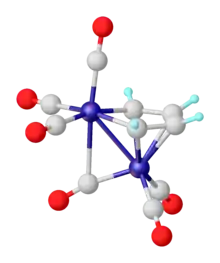Metallole
Metalloles are derivatives of cyclopentadiene in which the carbon atom at position 5, the saturated carbon, is replaced by a heteroatom. In contrast to its parent compound, the numbering of the metallole starts at the heteroatom. Some of these compounds are described as organometallic compounds, but in the list below quite a number of metalloids are present too.[1] Many metalloles are fluorescent. Polymeric derivatives of pyrrole and thiophene are of interest in molecular electronics. Metalloles, which can also be viewed as structural analogs of pyrrole, include:
| Name | M | d(M-C), Å | d(M-H), Å | α(C-M-C), ° | E, kJ/mol |
|---|---|---|---|---|---|
| Pyrrole | N | 1.37 | 1.01 | 110 | 0 |
| Phosphole | P | 1.81 | 1.425 | 90.5 | 67 |
| Arsole | As | 1.94 | 1.53 | 86 | 125 |
| Stibole | Sb | 2.14 | 1.725 | 80.5 | 160 |
| Bismole | Bi | 2.24 | 1.82 | 78 | 220 |
- Arsole, a moderately-aromatic arsenic analog
- Bismole, a bismuth analog
- Borole, a boron analog
- Furan (oxole), an oxygen analog
- Gallole, a gallium analog
- Germole, a germanium analog
- Phosphole, a phosphorus analog
- Plumbole, a lead analog
- Pyrrole (azole), a nitrogen analog
- Selenophene, a selenium analog
- Silole, a silicon analog
- Stannole, a tin analog
- Stibole, an antimony analog
- Tellurophene, a tellurium analog
- Thiophene, a sulfur analog
- Titanole, a titanium analog
- Zirconole, a zirconium analog

Structure of the ferrole complex Fe2(C4H4)(CO)6.[3]
See also
References
- Tracy, Henry J.; Mullin, Jerome L.; Klooster, Wim T.; Martin, James A.; Haug, Judith; Wallace, Scott; Rudloe, Isaac; Watts, Kimberly (2005). "Enhanced Photoluminescence from Group 14 Metalloles in Aggregated and Solid Solutions". Inorganic Chemistry. 44 (6): 2003–2011. doi:10.1021/ic049034o. PMID 15762727.
- Pelzer, Silke; Wichmann, Karin; Wesendrup, Ralf; Schwerdtfeger, Peter (2002). "Trends in Inversion Barriers IV. The Group 15 Analogous of Pyrrole". The Journal of Physical Chemistry A. 106 (26): 6387. Bibcode:2002JPCA..106.6387P. doi:10.1021/jp0203494.
- Dettlaf G, Weiss E. (1976). "Crystal structure, proton NMR and mass spectrum of tricarbonylferracyclopentadienetricarbonyliron, C4H4Fe2(CO)6". J. Organomet. Chem. 108: 213–23. doi:10.1016/S0022-328X(00)82143-9.CS1 maint: uses authors parameter (link)
This article is issued from Wikipedia. The text is licensed under Creative Commons - Attribution - Sharealike. Additional terms may apply for the media files.